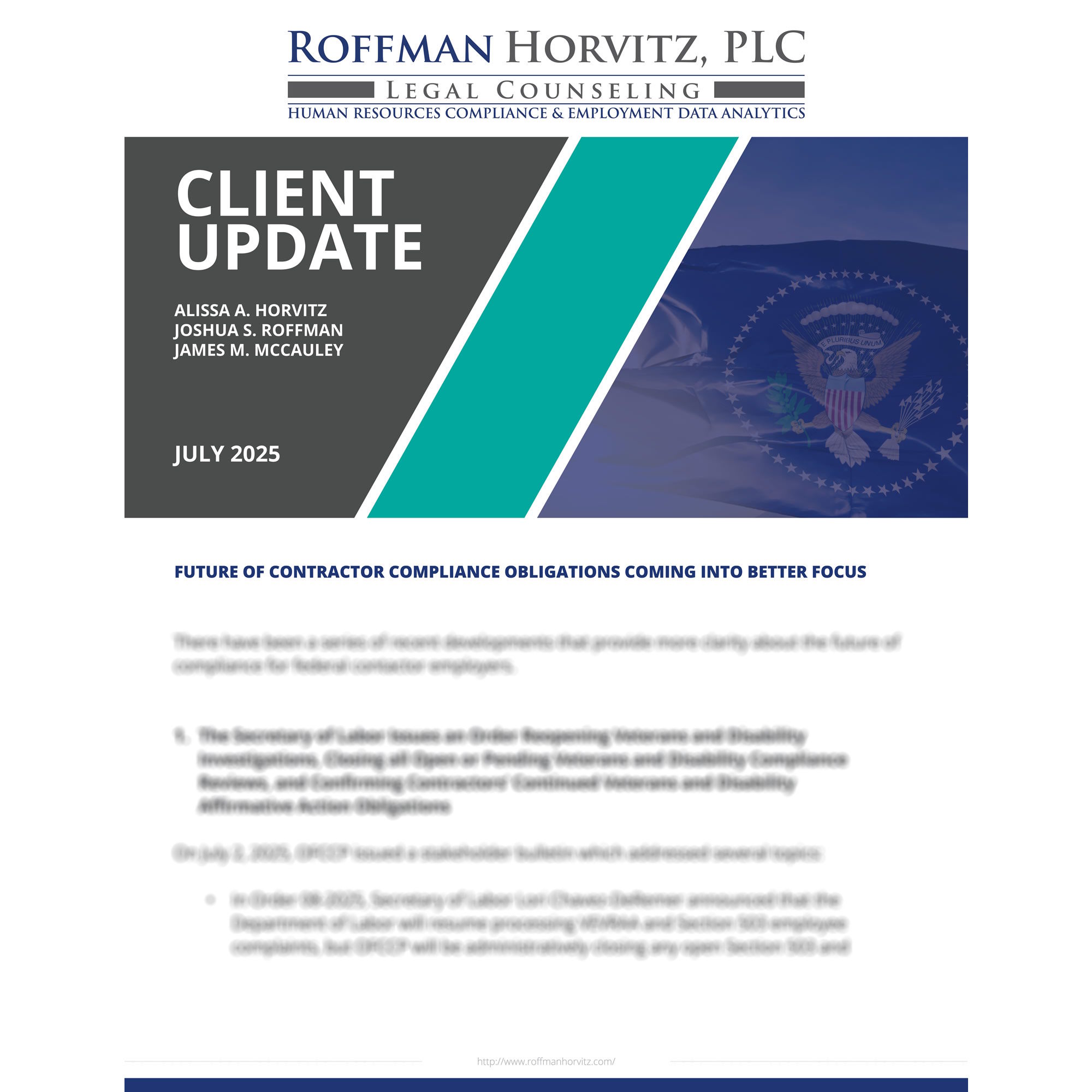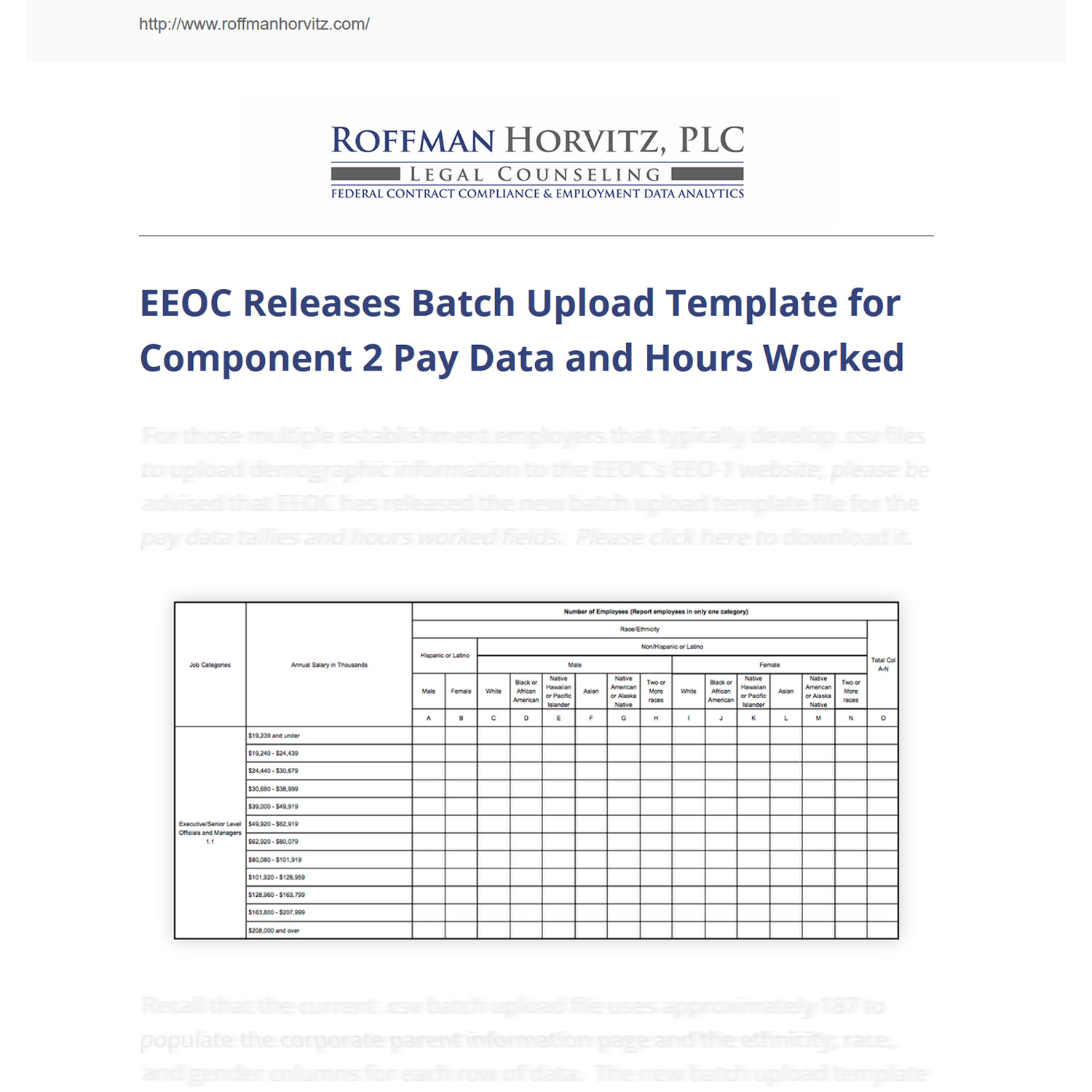Implications of the EEO-1 Filing for Government Contractor Employers.

The Equal Employment Opportunity Commission's EEO-1 portal will be open beginning the week of April 26 for the 2019 and 2020 reporting cycles. Employers have until July 19, 2021 to upload their data. The EEOC has opened its Frequently Asked Questions page, and we have a few notes and observations for our government contractor clients about the EEOC's Frequently Asked Questions and Answers.
This client alert addresses:
- data security and confidentiality,
- single legal entity issues,
- company organizational changes (mergers, acquisitions, spinoffs) and
- counting virtual or telework employees.
1. Data Security and Confidentiality
- The EEOC reminds filers that the EEOC may not divulge employer data to the public prior to the institution of any proceeding under Title VII. Any EEOC employee who violates this prohibition may be found guilty of a criminal misdemeanor and could be fined or imprisoned. EEOC is allowed to publish aggregated data and only in a manner that does not identify any particular filer or reveal any individual's personal information.
- What the EEOC's website does not disclose, however, is that the U.S. Department of Labor's Office of Federal Contract Compliance Programs (OFCCP) also receives Freedom of Information Act (FOIA) requests for these reports. OFCCP notifies the employer of its right to object to the release of the requested materials. OFCCP will withhold information in response to valid employer objections, but if the employer fails to object or fails to meet its legal burden to demonstrate why the information should not be disclosed, OFCCP will provide it.
- The data that EEOC collects is shared with OFCCP for employers that are government contractors and subcontractors, and the OFCCP collects three (3) years of EEO-1 filings any time it selects a government contractor for an Establishment Review, Functional Affirmative Action Plan Review, or Corporate Management Compliance Evaluation.
- In past years, individuals, academics doing research, civil rights advocacy groups, plaintiff class action law firms, and news media have submitted Freedom of Information Act (FOIA) requests to OFCCP to obtain government contractor employer data that they could not otherwise obtain from EEOC.
- There has been a sharp rise in both internal and external requests for demographic data in an effort to (i) get a sense of the employer's racial and gender baseline, (ii) benchmark the employer's data against other employers in the same geographical labor market or industry labor market using EEOC aggregated tables, and (for internal requests) (iii) develop action-oriented initiatives designed to improve those percentages, particularly for women and minorities.
- Employers need to understand the consequences for publishing this data internally. To be clear, we are not telling employers not to circulate or publish it. We are saying, however, that if you decide to release it internally, please understand the risk and implications it will create if you are faced with defending an external FOIA request. Whether the employer has maintained the data confidentially is one of the tests under the Supreme Court's Food Marketing Institute decision.
2. Single Entity Issues
- The EEOC's instructions explain that "if an establishment is affiliated through common ownership and/or centralized management with other entities in an enterprise with a total employment of 100 or more, the common ownership headquarters must file the EEO-1 Component 1 Report. The headquarters or parent company must file for all its subsidiaries and establishment/locations."
- The FAQ asks: If my organization has a different (i.e., separate) EIN than my parent company's corporate headquarters, should I file my EEO-1 Component 1 Reports separately? No. Your parent company's corporate headquarters is responsible for EEO-1 Component 1 Reports for your company as well as any other commonly owned, controlled, managed or affiliated subsidiaries/holdings.
- It is possible to designate each separate legal entity as a government contractor or not a government contractor using 1's (yes) and 2's (no), row by row in the Excel file. Whether different answers to the government contractor question/field row by row will be up-loadable without rejection in 2021 remains to be seen. If the system rejects different answers for different legal entities, then a “yes” answer for one legal entity will attach to all legal entities.
- During the Obama Administration, there was a sharp rise in "single entity" jurisdictional claims. OFCCP would select an establishment that did not perform work under a government contract for an audit, and if the employer objected to the OFCCP's jurisdiction, the OFCCP would place the burden on the employer to answer a series of lengthy questions in order to evaluate whether the entity selected for the audit was a "single entity" with other government contractor entities for purposes of keeping audit jurisdiction.
- In sum, the headquarters EEO-1 filing has significant implications for the affirmative action plan compliance obligations of all legal entities under that corporate umbrella.
3. Company Organizational Changes
- Companies must report acquisitions, mergers, and spinoffs that occurred between January 1, 2019 and December 31, 2020 prior to proceeding with filing.
- Employers do not need to wait until the portal opens on April 26 to report these changes, and can do so currently through the "Support Center" within the EEO-1 portal on eeocdata.org
- The options to submit company changes for mergers, acquisitions, or spinoffs will lead to online forms for employers to fill in and submit required information including establishment names, addresses, IDs, EINs, and contact information for new entities or entities involved in the organizational change.
- Contact information can also be updated through the site for employers that have not undergone an organizational change but would like to designate a different contact person for the report.
4. Virtual Employees and Telework
- The EEOC's FAQs state that "employees who telework, i.e., work from home, must be included in the EEO-1 Component 1 Report for the establishment to which they report."
- While that instruction probably is straightforward for 2019's filing, the pandemic may have altered how employers are counting employees for 2020.
- How you report employees on your EEO-1 filing influences how you must prepare your affirmative action plans. Unless you have obtained permission from OFCCP to prepare your affirmative action plans along Functional lines, the OFCCP will use your EEO-1 filing as its roadmap to select your establishments for audit.
- Every time you designate a brick-and-mortar building location as having 50 or more employees, OFCCP is expecting you to prepare an AAP for that location.
- In the past, employers had discretion to count employees at locations with fewer than 50 employees: "in an affirmative action program which covers just that establishment; in the affirmative action program which covers the location of the personnel function which supports the establishment; or, in the affirmative action program which covers the location of the official to whom they report." 41 CFR Section 60-2.1.
- If you have truly re-aligned your workforce because of the virtual and teleworking environment that the pandemic fostered, or to the extent that your AAP mapping was convoluted in the past, the 2020 EEO-1 filing may present a valuable opportunity to re-align the workforce so that the AAPs and EEO-1s are more aligned.
- The OFCCP is poised to announce the implementation of an AAP Verification Interface – a website designed to capture government contractor and subcontractor certification of compliance with the laws and regulations that OFCCP enforces. There is speculation that the OFCCP also will use this web portal to collect AAP data from government contractors, including those not under audit. It seems inconceivable that OFCCP will not want to compare the certifications it obtains from its proposed portal upload with the employer's EEO-1 filing to EEOC and follow-up on mis-matches (employer identifies as a prime or subcontractor to EEOC but does not submit any verification through the proposed interface).
If your organization has EEO-1 strategy, definition, or filing questions, we are available to assist. We also can cross-check your data file to ensure that you have employees in the correct EEO-1 classifications and format it for a seamless upload to the EEOC's portal to make is simpler for your organization to file and certify the reports.
Please let us know if we can be of any assistance.
Download PDF of Client Update

